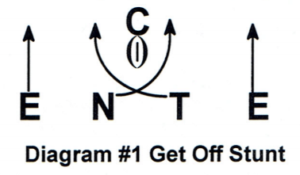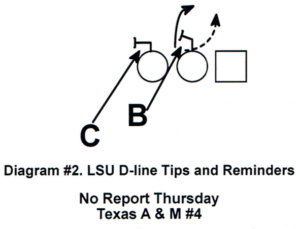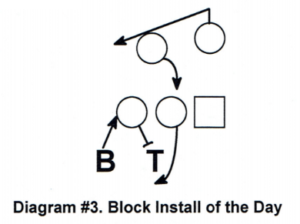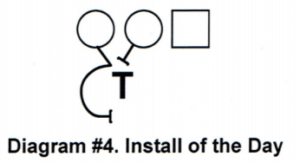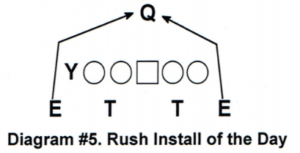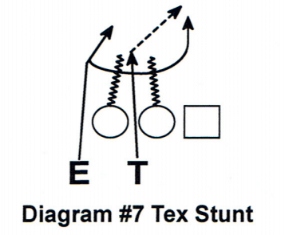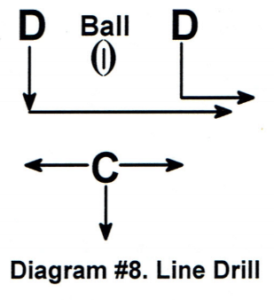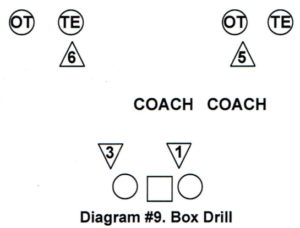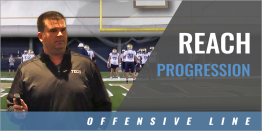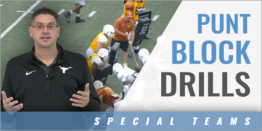|
By: Ed Orgeron - LSU Originally Published in: 2018 Nike Coach of the Year Clinic Manual - by Earl Browning Provided by: Nike Coach of the Year Thank you. We have a rule at LSU, and I learned it from Monte Kiffin. "If you want to get better then show up." Well, you showed up, and I am going to give you everything I have got today. I am going to go over some defensive line techniques. I see a lot of friends in here tonight. I see a lot of guys in here that I know, and you have helped me with recruiting. I cannot tell you how much I appreciate that. Recruiting is the lifeblood of our program. You guys bring your kids to camp, and when I am at your school, you are gracious to me. I know that for sure, and I have a lot of your players on my team. You tell me the truth. When you tell me this guy can play, it turns out he can. I want to tell you how much I appreciate that. Anything we can do as a football staff at LSU, I want to hear from you. I am going to give you a couple of things here that I really believe will help you. As an assistant coach there is no greater gift to the head coach, then to know your stuff. An assistant coach that is on it all the time and takes care of his players and business. His players are never in the head coach's office. LSU Football:
The number one thing, in my opinion, is to get your unit to perform on game day. I do not care what it takes. That is how we are judged. That is the results. I want to talk about the process. That is how we get it done. As an assistant coach, how do I get my unit to perform? If you want this stuff, let me know, and I will send it to you. I got it from someone else. These are not original thoughts. Do a great job where you work now, and you will never have to worry about your next job. If the head coach gives you a job, do it immediately. The head coach has a lot on his plate. If he comes to you and asks you to do a job, it means two things. He knows he can trust you and you will get the job done. When he asks you to do the job, he expects the coach to drop what he is doing and get the job done. It is important if the head coach asks you to do it. All your players want discipline. Every one of them. I do not ever remember a nice coach. Coaches that let me do stuff my way, I laughed at those guys. I needed a coach to kick me in the butt and get me better. You guys know what I am talking about. All players want discipline and structure in the proper way. Coach your best players the hardest and elevate the room. Everybody has them. We have the superstar sitting in the room. As the assistant coach in charge of his unit, I am going to get on his ass today as no one has ever seen. What happens is the rest of the players in the room will see that. If we do not get on the superstar and let him do the things that other people cannot do, our room will not get elevated. If you coach your best player the hardest, everyone else sees that. If someone is in a hole, throw them a rope, not a shovel. We have all been there. Throw that player a rope and pull him up. Coach positive, not negative. Bring him to the office after practice. You may have chewed his butt out in practice, but that is over, and we need to pull his spirits up. This is a good one. Most people know what to do, but few people do it. This next point comes from Pete Carroll. He said compete at everything you do. He is a great competitor and knows a lot about it. He competes when he gets up in the morning. He competes with his scrambled eggs. That is the way he is in life. Everything counts. That speaks to the success he has had. Here is another good one. Knowledge is power. Here is what I have learned over the years. I have been a head coach, and there is one thing I know, the players go first. I know that a lot of you coaches in this room are very successful coaches. The players go first, and they need to know that you care about their wellbeing. If they know you will do anything you can for them, then you have a shot at being successful. Knowledge is power. Be great at your position. Give them some stuff and they will come back to see you and will feed off you. They know that you are going to get them to a D-1 scholarship, so they can play in the SEC, where they can become an All-American, and a first-round pick in the NFL. They are going to be there for you, but they must know you care. Style of Coach:
I must be me. I cannot be anyone else. You must have a great attitude about work. You must bring it every single day. I am an early morning type of guy. Some guys are not like that, but it does not matter to me. When I get to work, it is work, and I am rolling. I have an attitude about it, and I love what I am doing. You must have knowledge of your position. That is what we are doing today. You must become good at what you do. The treatment of players boils down to one thing. You must be fair. I want to treat my players like I would my sons. I have three boys. I am going to treat my players like they were mine. I know they are someone's sons. Coaching Tools: Teaching progression
Here is what I am going to do. I know there are a bunch of assistant coaches in this room. I am going to challenge you a bit and ask you to raise your hand and respond. That was done to me. Where am I right now after I show you all the stuff I am going to show you? These are the things I learned from Rod Marinelli and Pete Jenkins. They are two of the best defensive line coaches in the country. They are two of the best assistants in the country. I have my stuff together. This is not my stuff. I learned it from someone else. The first thing you need is a good teaching progression. If someone came to me in an interview that is the first thing I want to know about him. Does he have a good teaching progression? Is he ready for the job? Stance and Alignment: The teaching progression I have I got from Butch Davis in 1988. The first thing we teach is the stance. We want the inside foot back and the inside hand on the ground. In our alignment, we have our fingertips on the butt of the ball. We are getting as close to the ball as humanly possible. We are so close to the ball that you can slide a credit card between our fingers and the ball. Our hands are behind the ball, and our heads are in the hands. Assignment: We play with a 3-technique defender on the tips of the guard's pad. The 6-technique defender is head up the tight end. You guys use the same stuff. The assignment has to do with the gap. We are a one-gap football team. The defender must play his gap. Get Off: The most important thing we do as a defensive line is "get off' the ball. The get off is essential in playing on the defensive line. We get off on the movement of the ball. We cannot be influenced by the cadence of the quarterback. He is trying to pull the defense offsides. Do not do your drills on "set hut." There is no movement in a defensive drill on sound. Always start with movement when coaching a defensive drill. Move your foot, the ball, a ball on a stick, or whatever it may be, but start with movement. Never go on sound. Hips and Hands: When teaching defensive techniques, you must emphasize the hips and hands of the defenders. If the defender is head up the offensive blocker, he has to use his hips and hands in his initial charge. The hands come from the ground to the man as quick as we can. We want a good stance with a good base and bend in the knees. The feet are parallel, the hips back, and the knees bent. On movement, the defender explodes with his hand into the breastplate of the blocker. The power comes from the hips. If the defender takes a step before he makes hand contact, he has no power in his hips. He wants to roll the hips and strike up into the breastplate with his hands and lockout with the elbows. The power step comes as the hands contact the blocker and the hips uncoil. An exercise you can do with your players illustrates the movement of the hands. Have your player stand with their arm extended in front of their chest. Have them roll their arms until the thumbs are pointing up. Then have them put their wrists together. They should experience the tightening and pull in their shoulder muscles. Striking with the thumbs up uses the proper muscles. If the defender is playing in an odd technique, he attacks with one hand. If he is a 3-technique defender, he is aligned on the outside eye of the blocker. As he comes out of his stance and delivers the blow, he uses the inside hand. We want to strike the blocker on the breastplate and let the hand slide upward to the throat of the blocker on the lockout movement. The other hand goes to the outside of the shoulder. Separation: When we get to the separation from the block, the defender has to lock out his arms. The key to working the release is to be violent. We play a primary gap and a second gap. If I am a 3-technique defender, my primary gap is the B-gap. However, if the ball is run into the A-gap, I can get into that gap as well. How many of you guys are old enough to remember the old TV show, "The Wide World of Sports; The thrill of victory and the agony of defeat." That was back when you could only get three stations on your TV. If you remember, they had the guys breaking a brick in a stack about four foot high. Did you ever see the guy break the brick with his head turned and his eyes looking away from the stack? Coach the eyes of your players. Watch what they are looking at. There is no way; the defender can knock the blocker on his butt if he is looking in the backfield. The only way the defender can look in the backfield is to defeat the block first. If he starts looking before he releases from the block, he gets buried. We can peek around the blocker, but we cannot raise up to see. The eyes lead the body, and the feet take you where you want to go. The 3-technique is responsible for the B-gap. He contacts his inside hand on the breastplate sliding to the throat. His outside hand goes to the outside shoulder pad of the offensive blocker. He wants to stay in that position. if he charges into the B-gap, the blocker turns his hips to the ball and blocks the defender to the outside. That creates a large gap in the A-gap. He wants to get control of the blocker then peek for the back. Release: The back reads the hips of the blocker. The defender wants to stay square on the block until the back gets inside the tackle box. How do I know when the ball is inside the tackle box? The defender reads the shoulders of the ball carrier. If the back turns his shoulders to the outside that is the way he is going. if his shoulders stay square, the defender wants to stay square on the blocker. The back commits to the B-gap and the 3-technique releases from the block. Next, he pulls down on the outside shoulder of the blocker and swims over the shoulder into the gap. When he gets into the gap, his knees are bent in a good football position, and he has a good base. If the defender does not have a good base, he can be pushed over very easily. That is why we do the slide and shuffle drills. Those drills teach the defender how to keep his base and never get caught with his feet together. Watch your players in a shuffle drill; they want to hop from side-to-side. When they hop, they end up with their feet together and have no power. Make them step and keep their feet on the ground. We want contact with the feet on the ground. If you do not get caught with your feet together, you have power and can strike from that position. Watch the players in your shuffle drills. If they are clicking their heels together, they have no base. To release to the outside, we lock out, pull on the outside shoulder to turn it inside and swim with the inside hand across the blocker. We can also use a two-handed throw to the inside. However, the only time the defender wants to use a rip-release is when the ball is outside the tackle box or goes to his inside gap. When we release off the offensive blocker, we have to throw them out of their shoes. We must be violent with our hands and throws. We do not want the offensive blocker to recover and get back on his block. Pursuit: Pursuit is an effort to the ball. It is hauling ass to the ball. Everyone cannot be talented, but everyone can display effort. That is all pursuit is. You want to get to the ball and arrive there in a bad mood. Tackle: I am going to show you some of the tackling drills we do. You must tackle well in today's game. It is basketball on grass for the offense. With the offenses today, if you miss a tackle, it is a touchdown. At LSU, I am the head coach, recruiting coordinator, assistant defensive line coach, and motivator. I am still going to coach. When the coordinator puts up the defense he wants to run, it is the position coach's job to decide what skills his unit is going to have and possess it takes to play that defense. Once he identifies the skills it takes for his unit to play the defense, he must come up with the drill to teach those skills. LSU Drill List: This list goes up in our locker room for all the players to see. Footwork:
Here are the drills that we are going to teach on defense. A lot of this stuff I got from Pete Jenkins. Pre-Practice Drills:
The hooray drill teaches the linemen to get off the ground. We do not want them to come off the ground like an old man gets up. When we do our shuffle drills, we make them do a belly flop on the ground. I want to see how fast they can get off the ground. The round bag drill is to teach the punch. They are smaller than the normal dummy. It makes the lineman keep his elbows tight to his rib cage and punch with his thumbs up. We do not want to hit a big bag. The smaller the bag, the smaller the target. Elbows in and thumbs up. In spring football practice, we have 30 minutes of individual drills. I am going to sit down with the defensive line coach, and we are going to put together the drills that need to be done, and we are going to do them every day for the entire spring practice. We know how the season works. On some days you have very little time for individual work. When I teach, I want to teach the skill first. After you are comfortable with that, we add another element to the drill. Do not get in a hurry to get to the product. You teach them how to punch with the hands, get their hips into the punch, and lockout. Once they master those skills without any trouble, then you add a running back to the drill. Sled Work:
The explosion drills are where I got better under the teaching of Coach Jenkins. We did a lot of good work with the explosion drills. The first drill we do is the "get off' drill. We start practice with this drill every day. The football in a game is aligned eight times on a yard line. That means that on 70 or more snaps, the ball is not on a line. Do not put the ball on a line. Put the ball in front of the line and make your players line up on the tip of the ball. We do not want them to get a clear look at the ball. We want them to concentrate on getting the proper alignment. We have a green ball, which we tell them that green equals money. The more sacks they get, the more money you will make in the NFL. We start with four players aligned on the tip of the ball. The coach moves the ball, and they get off. The coach moves the ball. We film the drills and see who reacts first. There is competition within the drills. We point those things out when we watch the film of the drills. After we do the first part of the drill, we align the four players in their relative positions and do the same thing. This allows them to align with their position and see the ball out of their peripheral vision. They must look at the blocker they are aligned upon but see the ball with their peripheral vision. If the ball or the man moves, we move. We are coiled like a rattlesnake ready to spring. We are taking all of the balls we can get. We try not to line up offsides but sometimes it happens, and we live with that. The third time we come through the get off drill, the coach calls cadence and tries to use the hard count to get the defenders to jump into the neutral zone. It takes discipline to not listen to the cadence and concentrate on the ball moving. We get in this part of the drill, but we are rarely offsides. The next thing we do is the get off with a stunt involved. (Diagram #1) Whatever stunt you need to practice you use it in this drill. All our run stunts turn into pass rush stunts. The difference is the way we attack the high hat read as an offensive blocker. We can tell the difference in a base block and a pass set. When we see the pass set, we are attacking the shoulder of the blocker and not punch him in a bull rush technique. We are clubbing and going around the blocker. If the blocker drive blocks, the defender punches, stays square, and plays his technique.
When we run our looping stunts, the defender wants to keep their shoulders as square to the line of scrimmage as they can. The square shoulders play well with run stunts. I want to tell you something about Louisiana. It is hot during the summer and early fall. When you play teams at LSU that must be an advantage for you. For it to be an advantage, the heat must be your friend. The only way the heat is my friend is to spend some time working in it. We must run in it and be ready for it. If you do not, the heat will be your enemy. When we do conditioning in the summer, I do this drill down the field and back. If they do not do it right, they do it again. It will be high noon in Louisiana in the highest heat. This gets them use to communicating and thinking when it is hot, and they are tired. Meetings:
Before I go home at night, I watch the tape of my individual drills. I am going to grade it, post the score, and be ready for my guys the next day. When I get to work the next day, I arrive before everyone else; I am going to have my meeting set. That is my job, and these are my players. Whatever happens during the day is going to happen, but those things are going to be done. I start off my meeting with NFL rushers. Your players are going to school, thinking about classes, and everything else except football. We must get them in the mood to have a good practice. You must get them fired up at that meeting. When you have a bad practice, the coach generally does a bad job of getting the team ready to practice. Coach Orgeron puts up a picture of an eagle. The caption under the picture said, When you chase two rabbits, you catch none." The title of the picture is "Focus." Monte Kiffin said, "If you see a lot, you see nothing. If you see a little you see a lot." Focus and do one thing at a time. Do not try to do too much. I have a seating chart for my meetings. I set the first unit on the first row and the second unit and third unit behind them. They are seated so that the positions line up in one row. The guy sitting behind the starting 3-technique is the 2nd team 3-technique. He is competing for that job. The first teamer better stay awake, not make any mistakes, and be active in the meeting. Everything at our place is a competition. It is healthy for the team and makes people try harder. You have seen great players that lacked motivation. They keep screwing up and not playing up their potential, you set him down and put the little hard working kids in front of him. In our meetings, it means something to be in the chair they are sitting in. If you are on the second team, do something about it. Great competition is healthy for a team. It is even healthy within the coaching staff if you do it the right way. They are constantly sharing and gaining knowledge from each other. If the assistant coach does not want to be the best assistant on the staff, he is in the wrong profession. You want to handle those things in the right way and not the wrong way. The defensive install of the day must be said exactly the way the defensive coordinator wants it said. The language must be the same throughout the staff. If he wants the 4-technique aligned nose-to-nose with the offensive tackle that is the way it is said. You have problems when the assistant says, "It will not work, but we will put it in." If that happens, you are done. The block install of the day is a teaching progression. I want to challenge all of you as coaches because that was the way I came up. I still challenge myself. If the head coach asked his assistant, what his player is doing and the coach answers, "I do not know." That is the wrong answer. You do not know, and you are his coach. He compounds his answer by telling the head coach that the player is not doing what he told him. The correct answer is, "Coach, I know he was wrong, and tomorrow I am going to use a drill to correct his mistake." That will mean a lot to the head coach. That is the coach being accountable for the mistake his player made. That shows accountability on the part of the assistant coach. I want to show you an example of our "Tips and Reminders." We have the capability to produce the tips sheets. The bullet points are general comments and things that are coming in practice. The first diagram shows a stunt for the corner and outside linebacker coming off the tips. The corner is coming off the edge and the tackle fans out to block him. The linebacker slants inside the guard and has a two way go in his pass rush. The down lineman to that side slanted across the center's face, and the linebacker should get home. This is another example of our tip sheet.
I go over the tip sheet with them during the meeting.
We have a section which shows them the block they need to be aware of today. When we teach how to play the double team, we work with the defensive tackles and nose. On a double team, the defender cannot whip two offensive linemen. He must take one of them on. In the 3-technique's situation, he wants to attack the outside blocker. He wants to get in the crack of the lineman. He shoots his punch into the outside blocker and twists his butt into the inside blocker.
The blockers have no power because they are being forced inside and outside. Neither of the offensive linemen can release without turning the tackle loose. They cannot get him out of the hole, and they cannot slip to the linebacker. With this rush pattern, we want the defensive end to come up the field for three steps and bend inside going for the quarterback. We want to attack his upfield shoulder, which is the back shoulder of the setup. In this situation, we are aligned with two 3-techniques. We cannot rush into those lanes and trap the quarterback. One of the 3-techniques is going to be a B-gap rusher, and the other is an A-gap rusher. That keeps the quarterback from running right up to the middle of the rush. We decide which 3-technique is going to be the A-gap rusher by scouting report on the protection scheme. You must understand which side the two-man side is, and which is the three-man side according to the formation. If you study the scheme, you can get the advantage most of the time. If the tight end releases, there will be a six-man protection scheme, with the running back being the sixth protector. (Diagram #5) If the running back aligns to the right, the center will block to the left. The defense must win the one-on-one rush battles.
We want to avoid the double team by the center and guard. If the guard sets to the right, the 3-technique to that side rushes through the B-gap and has a one-on-one block with the offensive guard.(Diagram #6) The other 3-technique becomes the A-gap rusher and is one-on-one with the guard. The center is blocking to the right.
This is a game I think you will like we call it a "Tex game." (Diagram #7) This is run to the two-man blocking surface. The left tackle is the penetrator because he gave a "me." The end is the "freezer." The left 3-technique rushes up the field and attacks the offensive tackle. He wants to pin his inside hip. From there he wants to ricochet to the quarterback.
The defensive end rushes up the field with his pads low and sells the outside move to the quarterback. If the offensive tackle turns to the inside to block the 3-technique coming outside, the defensive end rushes hard to the outside and attacks the quarterback. As the 3-technique works to pin the tackles inside hip, the offensive guard is blocking him. The defensive end loops back to the inside and attacks the guard. The guard tries to block the defensive end. The 3-technique ricochets straight to the quarterback. If the offensive guard continues to block on the defensive guard, the defensive end comes free to the quarterback. If the offensive tackle blocks down on the 3-technique, the stunt is off. We do not know what the players know. We must find out. We do that by asking questions. The players need to get ready to answer and know the answers when I ask them. We want to make sure the same guy does not answer all the questions. If that happens, you do not know what everyone else in the room knows. We are not trying to embarrass the player. We are trying to get him to communicate in the classroom. We set the tempo, and they are going to do it the way we want it done. They can bring a phone into the meeting room, but it must be turned off. If it is broke, you must fix it. The coaches are the ones who are going to watch the film and fix the problem. If it is broke, I can tell you how to fix it. If you go to the doctor and he gives you some medicine, who must take the medicine? I can put you in the drill, but you must fix it. We grade our pass rush. The players must grade 70 percent or more. The same thing goes for the defensive backs and wide receivers. If they cannot win 70 percent of their 1-on-1 matches, they cannot play in the SEC. You must film individual drills. That is the most important film of the day. If you are watching those films and studying them, you are ahead of the game. You want to grade effort and production. You do not want to necessarily play the player that has the best score on his grade sheet. You want to play the player that is more productive. If a player is filmed for sixty plays and only was productive on 10 of them, his ratio is not very good. If a player plays 20 plays and is productive on 11 of them, his ratio is much higher. We need to work on his technique, but he plays with effort and is productive. We chose this profession; you need to hit the field running. Nothing is more important to us. That is the attitude you must have. If you are on the scout team do the very best you can. If you are a fullback and must play linebacker, do the best job you can. Practice:
There is nothing worse than having someone drive the ball down your throat. There is no stopping. The defense must fit every play they run. LSU Fit Drill:
If the fit drill is a team drill, the quarterback takes the snap and hands the ball to a running back. He probes the line of scrimmage, backside, and outside. The defense must fit and pursuit in their gaps perfectly. 1 Gap Football:
Communication breeds confidence. If you understand and know what you are doing, you are talking on the field. You are communicating with your unit. When the defense is verbal in their play, it shows confidence, and they know what they are doing. I want the defensive linemen looking at the man across from him. The eyes are an important part of playing defense. However, you must look at the right things. I want him to see the blocker in front of him and have a feel for what is going on around him. Linemen looking in the backfield will get him cut down. That is a shame, and we must do a better job of coaching to prevent that from happening. Technique:
The purpose of the defense is to stop the run. It must be a rock-solid wall. Remember this; too much in the head. screws up the feet. Not a lot in the head and the feet are fast. That is another Monte Kiffin quote. We want to stop the run and have some fun. You must remember and know why we drill footwork. You want to play in a fundamental football position all the time. We do not ever want a railroad signal movement with the feet. That means they are crossed over one another in the form of an X. We have a drill to prevent that. It is called a "line" drill. (Diagram #8) The defenders get in a three-point stance and on the coach's movement they react. The coach gives them three different movements. The coach uses hand signals and movements to let the linemen know what to do. On movement, the defender gets off the ball with a straight-ahead charge. They react to the coach's signal. He gives them a high hat or redirects the right or left. When we redirect, our steps do not round off the movement. We stick the foot in the ground square the shoulder and run down the line of scrimmage. We call that a corkscrew move.
I must show you this drill. It is a 6-point layout drill. On this drill, we are on the knees in front of the sled. We want to work hips, legs, and lower back. That is the way you deliver a blow. The hands are only used for leverage. The hand is used to control the block. The power comes from the hips, legs, and lower back. We do not have a ball in this drill but move on the coach's foot. You can do this drill using a man instead of the sled. A coaching point is to have the next man in line hold the ankles of the player doing the six-point layout. That makes him extend and thrust with his legs. His hips will drop to the ground after the contact. His hands come up into the sled as he contacts his punch. We go from there to the 3-point layout. The defender does the same thing in the 3-point layout that he did in the 6-point. The difference is he does not end up on the ground. He delivers the blow and locks out on the sled. We take the next step which is punch, lockout, and peek. The last part is to put a runner behind the sled. The defender explodes into the sled, locks out, peeks, then comes off the sled and attacks the back. That is a progression of skills. We do a box drill. (Diagram #9) We put two offensive blockers and one defender at the edge of the box on either end. We are working for two pods at the same time. The assistant line coach watches one, and the defensive line coach watches the other. The defenders align in defensive techniques. In the diagram, the two defenders are in a 7 and 5-technique. The offense goes on a cadence, and the defenders play their technique against two offensive linemen.
On the other side of the box, we have the interior defenders working a three-on-two drills. The defender plays their techniques against the offensive blockers. We work half-line drills. We put one group between the hash marks and the sidelines and the other group on the other side between the hash marks and the sidelines and run half-line drills. This allows you to see techniques clearer with fewer people in the drill. We work a 3 and 5-technique and linebacker against the center, guard, tackle, fullback, and running back. One group is the right side of the defense, and the other group is the left side players. We have two groups going at the same time. Or we can alternate groups, so all the positions coaches can work for each group. We went to a 3-4 defense last year to help stop the option play. There are two types of tackling that goes with the defense. There is react and attack, and there is attack and react. Those are two different techniques in tackling. If we are playing in a 3-4 defense, we are a react and attack technique. You must react first. In a 4-technique, the defender must react to the movement of the offensive lineman and then attack the blocker. If the blocker goes inside, the defender reacts to that move by moving and squeezing to the inside and then attacking the blocker. The other technique is attacked and react. If the offensive blocker moves inside, the defender attacks the blocker with his hands and reacts to whatever the play is. The difference is when the defender attempts to control the blocker. In the react technique the defender moves with the blocker before he engages with his hands. On the other technique, it is just the opposite. On the blocker's movement, the defender attacks with his hands and then reacts to what the blocker does. |



